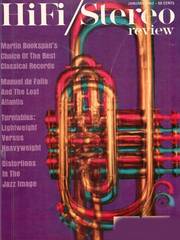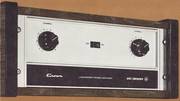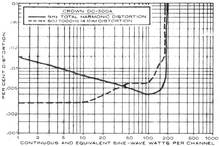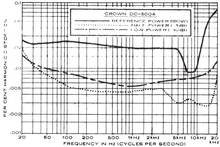Ein Test aus STEREO REVIEW um 1972
Die Zeitschrift STEREO REVIEW aus den USA haben wir nur teilweise in Bruchstücken bis etwa 1962. Da gab es den CROWN DC300 noch nicht. Manche Artikel aus den 1960er Jahren sind für den heutigen Leser oder Redakteur (aus dem Jahre 2014) schon sehr gewöhnungsbedürftig. Denn da drüben (in USA) wurde gnadenlos zugeschlagen, jedenfalls in der Werbung und die Zeitschriften waren drüben in den USA genauso abhängig von den Inserenten wie hierzulande.
.
Crown DC-300A Stereo Power Amplifier
One of the first highly regarded "super-power" solid-state amplifiers, the Crown DC-300, is now available in an updated version as the DC-300A.
Was ist der CROWN DC-300A ?
Despite the superficial resemblance of the two amplifiers and their somewhat similar specifications, the circuits of the 300A have been completely redesigned. The Crown DC-300A has a 7" x 19" panel, intended for rack mounting, and extends 9 3/4" behind the mounting surface. The amplifier weighs 45 pounds.
Two large knobs on the panel control the input sensitivity of each channel, and the only other external control is a heavy-duty rocker switch that turns the amplifier on and lights up to serve as a pilot indicator. The speaker terminals (which are heavy-duty binding posts) and the input connectors (standard 1/4" phone jacks) are in the rear of the amplifier, as is the a.c. line fuse.
.
Ein "integrated-circuit operational amplifier"
Most of the gain in each channel is obtained from a single integrated-circuit operational amplifier, replacing a considerable number of discrete transistors and other parts performing the same function in the original DC-300 amplifier. The input impedance at full gain settings is 10,000 ohms. The number of output transistors in each channel has been doubled, from four (in the DC-300) to eight. There are no output fuses, but an elaborate electronic protection system safeguards the amplifier against short circuits, mismatching, or open circuits, as well as problems that may be provoked by reactive loads. The amplifier is completely direct-coupled from input jacks to speakers, and is completely free of transient pulses in its audio outputs during a.c.-power switching.
.
Über die Ausgangsleistung
The DC-300A carries several power ratings, including 190 watts per channel at the clipping point (8ohm loads) and 420 watts IHF dynamic power output into 8ohms. Its overall performance is thoroughly described in some fourteen separate graphs in the exceptionally complete instruction manual. For most purposes, the reference full-power output is 150 watts per channel into 8 ohms. Although the amplifier is normally rated for use with loudspeaker loads of 4 to 8 ohms, its maximum power is delivered into 2.5 ohms, and lower impedances can be used with no adverse effects except a reduction of maximum power output available.
Über den Klirrfaktor
The most impressive specifications of the DC-300A relate to its distortion, which is far lower than that of the most advanced laboratory test equipment. Using external filters, Crown has managed to lower the minute residual distortion of the best available audio generators to less than 0.0001 per cent. Crown's curves for the DC-300A are therefore able to show that its distortion is between 0.0001 and 0.01 percent over the 20 to 20.000 Hz range, 150 watts per channel into 8-ohm loads.
Making a Mono-Amp
For special applications, a simple internal connection converts the DC-300A into a single-channel mono amplifier with a typical clipping power output of 650 watts into either a 4 or 8ohm load. Most of the other specifications remain unchanged in this mode of operation.
Ganz wichtig : der Preis
The Crown DC-300A costs $695. A walnut cabinet in $37 additional.
Laboratory Measurements
With both channels driven into 8-ohm loads with a 1,000-Hz test signal, the outputs clipped at 185 watts per channel. Into 4 ohms, the output was 325 watts per channel, and into 16 ohms it was 102 watts per channel.
An input of 0.43 volt was required for a 10-watt output (about 1.75 volts drives the amplifier to full power). The noise was 88dB below 10 watts, or 100dB below the rated 150 watts. Crown bases its 110dB noise rating on a measurement bandwidth limited to 20,000 Hz, so the published specification is consistent with our measurement made over a much wider frequency range.
Wir nehmen mal 180 Watt /Kanal als Referenz
Although the DC-300A carries a 150-watt per channel rating, we noted that its distortion was almost independent of power and frequency up to its clipping point; therefore, we chose 180 watts as a reference full-power output. At this level, harmonic distortion was between 0.02 and 0.025 per cent at full power over most of the audio-frequency range, reaching 0.08 per cent at 20,000 Hz.
At lower power levels, the distortion was typically between 0.003 and 0.01 per cent over the full frequency range. Our test-equipment residual distortion is about 0.002 per cent.
The harmonic distortion
The harmonic distortion, because it was so low, was masked by a random-noise component (also inaudible) at most operating levels. The combined noise and distortion reading varied from 0.015 per cent at 1 watt to 0.004 per cent at 100 watts, and was only 0.0045 per cent at the rated 150 watts.
The inter-modulation
The inter-modulation (IM) distortion was about 0.003 per cent (essentially the residual of the test equipment) up to 10 watts, increasing to 0.012 per cent at 150 watts. The absence of 'crossover" distortion was apparent in the very low-power IM measurements, which reached a maximum of a mere 0.014 per cent at just about 3 milliwatts output.
The frequency response
The frequency response was flat from our lower measurement limit of 5 Hz (actually, it is flat to d.c. or "zero" Hz) through the audio range, falling to -0.6dB at 50,000 Hz and -3dB at 170,000 Hz. Square-wave rise time was about 4 microseconds. The d.c. offset voltage appealing across the speakers was an almost immeasurable 3 millivolts.
Comment:
The Crown DC-300A almost defies comment. Though it is not the most powerful amplifier available, it may well be the "safest" for use with a wide range of loads. No load we could apply - including short circuits and large capacitors - had any significant effect on its operating characteristics.
Prolonged high-power operation during testing eventually activated the DC-300A's protective circuits, as it should have. In normal operation, with speakers of extremely low efficiency, the amplifier did not even become noticeably warm to the touch.
Most engineers would probably be impressed, as we were, by the incredibly low distortion of this amplifier. However, we think the audiophile user is more likely to benefit from its foolproof circuit design.
Some otherwise excellent high-power amplifiers occasionally have problems with special loads or inadequate external cooling, but the DC-300A seems to be able to handle these conditions without difficulty.
While we obviously could not apply all possible conditions of improper operation to the DC-300A, we tried our best, and it survived unscathed.
A most impressive amplifier
It is, in short, a most impressive amplifier, one that has no flaws or functional weaknesses that we could detect.
Anmerkung :
1972 - Wieder solch ein blöder Test zur Verdummung der Interessenten bzw. der Kunden. Wo ist der Hörtest an wirklich guten Boxen mit einer guten Quelle ? Mit solchen halbfertigen Artikeln wurden wir damals geködert, nur noch K3 Verzerrungen zu erahnen und IM zu hören.
Und als Karl Breh hier bei uns in Deutschland so um 1978 anfing, diesen ganzen Mist in Frage zu stellen und den eigentlichen Klang zu beurteilen, waren die Hersteller und Liefanten sauer und schalteten keine Anzeigen mehr. So wurde die Hifi-Stereophonie quasi wegen ihrer Kompetenz und Redlichkeit erdrosselt. Diese Wahrheit wollte so niemand hören, selbst heute noch nicht.
.





